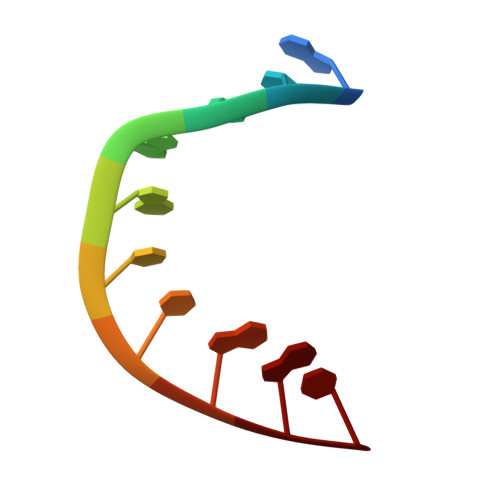Influence of counter-ions on the crystal structures of DNA decamers: binding of [Co(NH3)6]3+ and Ba2+ to A-DNA.
Gao, Y.G., Robinson, H., van Boom, J.H., Wang, A.H.(1995) Biophys J 69: 559-568
- PubMed: 8527670
- DOI: https://doi.org/10.1016/S0006-3495(95)79929-5
- Primary Citation of Related Structures:
212D, 220D, 221D, 222D - PubMed Abstract:
A-DNA is a stable alternative right-handed double helix that is favored by certain sequences (e.g., (dG)n.(dC)n) or under low humidity conditions. Earlier A-DNA structures of several DNA oligonucleotides and RNA.DNA chimeras have revealed some conformational variation that may be the result of sequence-dependent effects or crystal packing forces. In this study, four crystal structures of three decamer oligonucleotides, d(ACCGGCCGGT), d(ACCCGCGGGT), and r(GC)d(GTATACGC) in two crystal forms (either the P6(1)22 or the P2(1)2(1)2(1) space group) have been analyzed at high resolution to provide the molecular basis of the structural difference in an experimentally consistent manner. The study reveals that molecules crystallized in the same space group have a more similar A-DNA conformation, whereas the same molecule crystallized in different space groups has different (local) conformations. This suggests that even though the local structure is influenced by the crystal packing environments, the DNA molecule adjusts to adopt an overall conformation close to canonical A-DNA. For example, the six independent CpG steps in these four structures have different base-base stacking patterns, with their helical twist angles (omega) ranging from 28 degrees to 37 degrees. Our study further reveals the structural impact of different counter-ions on the A-DNA conformers. [Co(NH3)6]3+ has three unique A-DNA binding modes. One binds at the major groove side of a GpG step at the O6/N7 sites of guanine bases via hydrogen bonds. The other two modes involve the binding of ions to phosphates, either bridging across the narrow major groove or binding between two intra-strand adjacent phosphates. Those interactions may explain the recent spectroscopic and NMR observations that [Co(NH3)6]3+ is effective in inducing the B- to A-DNA transition for DNA with (G)n sequence. Interestingly, Ba2+ binds to the same O6/N7 sites on guanine by direct coordinations.
Organizational Affiliation:
Division of Biophysics, University of Illinois at Urbana-Champaign 61801, USA.














